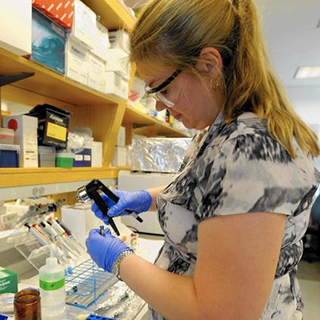December 17, 2021

As an environmental chemist, Heather Stapleton, Ph.D., uses advanced analytical techniques to understand what chemicals people are exposed to in different situations and how they affect health.
One of her focus areas is harmful chemical exposures that people may encounter in their homes, such as from consumer products and building materials treated with flame retardants.
The Dangers of Indoor Dust
Stapleton’s interest in studying chemicals in the home began when she was a postdoctoral researcher with the National Institute of Standards and Technology (NIST). There, she helped to develop Standard Reference Materials to ensure accuracy and precision in lab measurements for flame retardants.
“NIST had developed a pooled house dust sample to support lead testing, and I was curious to see if we could also detect flame retardants. After analyzing the sample, I was shocked at how high the concentrations were,” Stapleton said. “At that time, exposure to flame retardants was thought to occur through contaminated food or the outdoor environment. But in reality, we have much higher exposure to these and other chemicals indoors compared to outdoors.”
Now co-director of the NIEHS-funded Superfund Research Program (SRP) Center at Duke University, Stapleton has made significant discoveries about how chemicals in house dust can affect health.
For example, she found that house dust can contain chemicals that disrupt thyroid hormones, which regulate the body’s metabolism, brain development, and bone maintenance.
In another study, Stapleton found that wallboards used in home construction can contain a type of fungicide that is potentially neurotoxic to people and may find its way into house dust. She completed this research in collaboration with Mark Zylka, Ph.D., an NIEHS grantee at the University of North Carolina at Chapel Hill.
“One person can’t do it all. Our scientific contributions and knowledge are often better when they stem from team projects rather than the individual projects,” said Stapleton. “Most of my work, particularly with the Duke SRP Center, involves team science and interdisciplinary collaborations. Answering complex research questions, particularly when it comes to human exposure and health effects, requires expertise in several different fields.”
Monitoring Exposure
Stapleton is also joining forces with North Carolina State University researcher Matthew Breen, Ph.D., who studies canine cancer. They are using dog tags and silicone wristbands to detect chemical exposures in dogs and their owners to gain insight into how daily exposure to chemicals may affect health.
Stapleton previously reported that silicone wristbands can be useful noninvasive tools to monitor chemical exposure to mixtures and evaluate their biological activity. The wristbands were developed by NIEHS-funded researcher Kim Anderson, Ph.D., from Oregon State University.
The team found that humans generally had as their canine companions. They plan to study dogs over time to determine if genetic differences and environmental exposures increase the likelihood of developing certain types of cancers, such as bladder cancer.
“It's really difficult to study the development of diseases with long latency periods, such as cancer, in people,” said Stapleton. “But dogs give us a unique opportunity because they have a more compressed lifespan compared to their owner, yet they share the same home, and chemical, environment.”
Recognition for Outstanding Research

In 2008, Stapleton received the Outstanding New Environmental Health Scientist (ONES) award to study children’s exposure to flame retardants and their effect on thyroid hormone regulation, with a focus on developmental health risks. This award supports talented environmental health scientists in the early, formative stages of their careers and helps them launch innovative research programs.
“The ONES award meant almost everything to me, and I don't think I would be where I am today without it,” said Stapleton. “It’s difficult to summarize all the research we’ve conducted thanks to the award. It provided me with the opportunity to buy equipment for my lab and develop new methods to measure thyroid hormones, which are helping us to answer a lot of different questions focusing on sources of chemical exposures and effects on development.”
In 2019, Stapleton received an NIEHS grant to establish the Duke Environmental Analysis Laboratory as part of the NIH’s Human Health Environmental Analysis Resource (HHEAR). There, Stapleton leads a team that provides scientists access to cutting-edge tools to characterize known and unknown chemical contaminants in biological and environmental samples.


